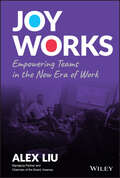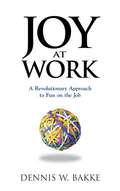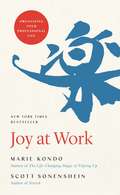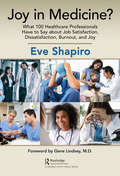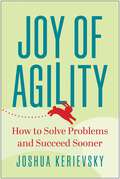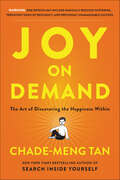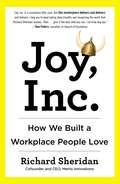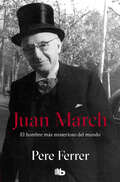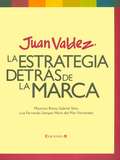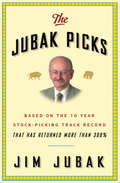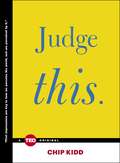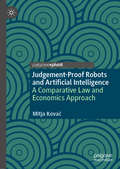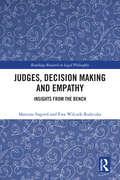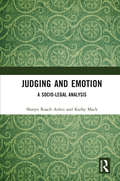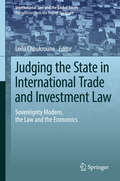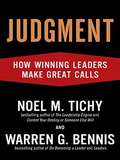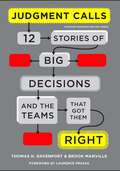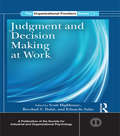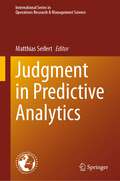- Table View
- List View
Joy Works: Empowering Teams in the New Era of Work
by Alex LiuJoy at work—why settle for anything less? In Joy Works: Empowering Teams in the New Era of Work, Alex Liu delivers an engaging blueprint for ensuring people feel safe and inspired at work. Liu, the managing partner and chairman of Kearney, asks, "Why would we settle for anything less than joy at work?" In the book, you'll find a step-by-step action plan for approaching joy at work using the three key drivers that determine employee happiness—people, praise, and purpose—and learn how to implement that plan for maximum results and maximum joy. The author demonstrates how to create more joy for your people at work, in both virtual and in-person environments, as well as how to incorporate joyfulness even in periods of dramatically heightened stress. He calls on his years of conversations with leaders around the world, both as an advisor to executives and through his popular podcast, Joy@Work. Readers will learn from a diverse collection of leaders, from psychologists, academics, athletes, nonprofit and board leaders, and a Broadway producer, to leaders at companies including HPE, Cisco, T-Mobile, SAP, and UPS. In the dialogues and research, readers will also find: An introduction to "ikigai," a Japanese concept meaning "reason for being"—a framework we can all use to find joy and meaning in our work An investigation into the link between social justice and joy, using conversations with leaders who have committed to making social progress a priority A new perspective on how the next generation will view joy at work, the Great Reflection, and the shifting balance of power in work cultures In-depth discussions about people, purpose, and praise: the three key elements in building a joyful work experience A call for more reflective leadership—a new approach to power leaders through uncertain and challenging times Joy Works is an essential handbook for anyone who wants to create more joy in their work — the leaders who want to shift corporate cultures, managers who are facing pressures to innovate, young people who are adamant that they can have a life and a career that's centered around joy and meaning, and anyone who thinks "joy at work" is a near-term possibility, not an oxymoron. This guide to the changing reality and opportunity of work belongs in the libraries of anyone interested in creating a more engaging and productive virtual, hybrid, or in-person workspace. Let's build more joy.
Joy at Work
by Dennis W. BakkeImagine a company where people love coming to work and are highly productive on a daily basis. Imagine a company whose top executives, in a quest to create the most "fun" workplace ever, obliterate labor-management divisions and push decision-making responsibility down to the plant floor. Could such a company compete in today's bottom-line corporate world? Could it even turn a profit? Well, imagine no more.In Joy at Work, Dennis W. Bakke tells the true story of this extraordinary company--and how, as its co-founder and longtime CEO, he challenged the business establishment with revolutionary ideas that could remake America's organizations. It is the story of AES, whose business model and operating ethos -"let's have fun"-were conceived during a 90-minute car ride from Annapolis, Maryland, to Washington, D.C. In the next two decades, it became a worldwide energy giant with 40,000 employees in 31 countries and revenues of $8.6 billion. It's a remarkable tale told by a remarkable man: Bakke, a farm boy who was shaped by his religious faith, his years at Harvard Business School, and his experience working for the Federal Energy Administration. He rejects workplace drudgery as a noxious remnant of the Industrial Revolution. He believes work should be fun, and at AES he set out to prove it could be. Bakke sought not the empty "fun" of the Friday beer blast but the joy of a workplace where every person, from custodian to CEO, has the power to use his or her God-given talents free of needless corporate bureaucracy.In Joy at Work, Bakke tells how he helped create a company where every decision made at the top was lamented as a lost chance to delegate responsibility--and where all employees were encouraged to take the "game-winning shot," even when it wasn't a slam-dunk. Perhaps Bakke's most radical stand was his struggle to break the stranglehold of "creating shareholder value" on the corporate mind-set and replace it with more timeless values: integrity, fairness, social responsibility, and a sense of fun.
Joy at Work: Organizing Your Professional Life
by Marie Kondo Scott SonensheinDeclutter your desk and brighten up your business with this transformative guide from an organizational psychologist and the #1 New York Times bestselling author of The Life-Changing Magic of Tidying Up.The workplace is a magnet for clutter and mess. Who hasn't felt drained by wasteful meetings, disorganized papers, endless emails, and unnecessary tasks? These are the modern-day hazards of working, and they can slowly drain the joy from work, limit our chances of career progress, and undermine our well-being.There is another way. In Joy at Work, bestselling author and Netflix star Marie Kondo and Rice University business professor Scott Sonenshein offer stories, studies, and strategies to help you eliminate clutter and make space for work that really matters.Using the world-renowned KonMari Method and cutting-edge research, Joy at Work will help you overcome the challenges of workplace mess and enjoy the productivity, success, and happiness that come with a tidy desk and mind.
Joy in Medicine?: What 100 Healthcare Professionals Have to Say about Job Satisfaction, Dissatisfaction, Burnout, and Joy
by Eve ShapiroEve Shapiro has been writing about patient-centered care, physician–patient communication, and relationships between doctors and their patients since 2007. In Joy in Medicine? What 100 Healthcare Professionals Have to Say about Job Satisfaction, Dissatisfaction, Burnout, and Joy, Eve turns her attention to those on the healthcare delivery side of this "sacred interaction." These healthcare professionals share their enthusiasm, joys, frustrations, disappointments, insights, advice, stories, fears, and pain, explaining how it looks and feels to work in healthcare today no matter who you are, where you work, or what your position is in the organizational hierarchy. The healthcare professionals who provide patient care deserve our collective interest in their humanity. Without some insight into who they are and the forces with which they struggle every day, we cannot fully appreciate the obstacles to providing the care we all want for ourselves and our families during the best of times, let alone in the uncertain times that lie ahead.
Joy of Agility: How to Solve Problems and Succeed Sooner
by Joshua KerievskyAgility enables you, your team, and your organization to streamline slow and awkward actions, overcome obstacles quickly, and adapt to change with ease and grace. Agility isn&’t a formula, a framework, nor a set of roles and rituals to follow. It&’s a timeless way of being that matures with practice and skill. Becoming agile involves knowing the difference between being quick or hurrying, moving with ease or difficulty, being in or out of balance, graceful or awkward, adaptable or rigid, resourceful or resentful. With Joy of Agility, Joshua Kerievsky, CEO of Industrial Logic, one of the oldest and most-respected agile consultancies in the world, shows you how to harness agility in work and life to solve problems and succeed sooner. Kerievsky shares six essential agile mantras, plus unforgettable, real-world stories of agile people and teams, that will empower you to be quick, adaptable, and resourceful in the face of challenges and opportunities. Learn how to: Distinguish between being quick and hurrying Gain better balance and collaborate gracefully with others Prepare and practice being poised to adapt Take deliberate steps to drive out fear Grow a solution by starting minimal and evolving Overcome obstacles by being readily resourceful Use the lessons learned in Joy of Agility to transform agility from a mere buzzword into an approach that helps you obtain triumphant results.
Joy on Demand: The Art of Discovering the Happiness Within
by Chade-Meng TanA long-awaited follow-up to the New York Times bestselling Search Inside Yourself shows us how to cultivate joy within the context of our fast-paced lives and explains why it is critical to creativity, innovation, confidence, and ultimately success in every arena.In Joy on Demand, Chade-Meng Tan shows that you don’t need to meditate for hours, days, months or years to achieve lasting joy—you can actually get consistent access to it in as little as fifteen seconds. Explaining joy and meditation as complementary things that naturally reinforce each other, Meng explains how these two skills form a virtuous cycle, and once put into motion, become a solid practice that can be sustained in daily life.For many years, meditation has been taught and practiced in cultures where almost all meditators practice full-time for years, resulting in training programs optimized for practitioners with lots of free time and not much else to do but develop profound mastery over the mind. Seeing a disconnect between the traditional practice and the modern world, the bestselling author and Google’s “Jolly Good Fellow” has developed a program, through “wise laziness,” to help readers meditate more efficiently and effectively. Meng shares the three pillars of joy (inner peace, insight, and happiness), why joy is the secret is to success, and demonstrates the practical tools anyone can use to cultivate it on demand.
Joy, Inc.
by Richard SheridanLast year 2,197 visitors came from around the world to visit Menlo Innovations, a small software company in Ann Arbor, Michigan. They made the trek not to learn about technology, but to witness a radically different approach to workplace culture- one intentionally designed to produce joy. CEO and Chief Storyteller Rich Sheridan removed the fear and ambiguity that typically make a workplace miserable. With joy as the explicit goal for Menlo’s staff, as well as their clients and the people who use the products they create, Sheridan and his team changed everything about how the company was run. Now he offers an inside look at a shared belief system that influences physical space, embraces making mistakes, and eliminates meetings-all while fostering dignity and respect for the team. Joy, Inc. is for readers in any field who want tangible examples of a healthier, happier atmosphere at work-leading to the sustainable business results required for growth. .
Joy, Inc.
by Richard SheridanThe moment you walk into Menlo Innovations, you can sense the atmosphere full of energy, playfulness, enthusiasm, and maybe even . . . joy. As a package-delivery person once remarked, "I don't know what you do, but whatever it is, I want to work here."Every year, thousands of visitors come from around the world to visit Menlo Innovations, a small software company in Ann Arbor, Michigan. They make the trek not to learn about technology but to witness a radically different approach to company culture.CEO and "Chief Storyteller" Rich Sheridan removed the fear and ambiguity that typically make a workplace miserable. His own experience in the software industry taught him that, for many, work was marked by long hours and mismanaged projects with low-quality results. There had to be a better way.With joy as the explicit goal, Sheridan and his team changed everything about how the company was run. They established a shared belief system that supports working in pairs and embraces making mistakes, all while fostering dignity for the team.The results blew away all expectations. Menlo has won numerous growth awards and was named an Inc. magazine "audacious small company." It has tripled its physical office three times and produced products that dominate markets for its clients.Joy, Inc. offers an inside look at how Sheridan and Menlo created a joyful culture, and shows how any organization can follow their methods for a more passionate team and sustainable, profitable results. Sheridan also shows how to run smarter meetings and build cultural training into your hiring process.Joy, Inc. offers an inspirational blueprint for readers in any field who want a committed, energizing atmosphere at work--leading to sustainable business results.
Joy4Home Brands: Pricing Matters
by Elie Ofek Marco Bertini Oded KoenigsbergJoy4Home Brands, the maker of novel houseware items, was gearing up for its launch. The company would be introducing two lines: kitchenware products and storage containers. The initial go-to-market plan called for a direct to consumer (DTC) channel strategy. While Joy4Home had a handle on its customer acquisition efforts, it had yet to determine the DTC pricing for each line. Moreover, two additional opportunities had recently emerged. The first was a B2B opportunity involving a modified kitchenware line, and the second was a brick-and mortar wholesale proposal for larger storage containers. The Chief Marketing Officer (CMO) had market research data and other information to help her determine the optimal pricing scheme for these various sales avenues. Recommendations were needed soon.
Juan March: El hombre más misterioso del mundo
by Pere Ferrer«March entendía que la política solo era una palanca para sacarse del medio aquello que le estorbaba». El personaje que representó March en la vida tuvo muchas facetas novelescas. Se inició en el contrabando, estuvo involucrado en el asesinato de su socio y amante de su mujer (un crimen jamás resuelto), tuvo incontables aventuras amorosas... El doble juego que practicó en las contiendas bélicas del siglo XX le convirtió en uno de los hombres más ricos de Europa. Fue una controvertida figura política: escapó de la cárcel de Alcalá de Henares, donde estuvo preso durante la República; financió la revuelta militar de julio de 1936 y se opuso al general Franco durante los cuarenta, apostando por la monarquía. Y finalmente, de forma rocambolesca, se apropió de la Barcelona Traction y la obra de mecenazgo de la Fundación March. Pere Ferrer relata en estas páginas la biografía de la polémica trayectoria del banquero mallorquín, un hombre ambicioso y brillante, creador del primer emporio de las islas Baleares.
Juan Valdéz. La estrategia detrás de la marca
by Varios AutoresLa estrategia para posicionar a una de las marcas más icónicas del país. Juan Valdez, su mula Conchita y el paisaje montañoso son la imagen del café colombiano en el mundo. Estos tres íconos han impulsado la imagen del café colombiano y a lo largo de 50 años de existencia, han sufrido una serie de transformaciones que han ayudado a que hoy se reconozca el café colombiano como el más rico del mundo.
Jubak Picks: 50 Stocks That Will Rebuild Your Wealth and Safeguard Your Future
by Jim JubakThe Investing Strategy for All Seasons The Jubak Picks enables you to play great offense and great defense: to make money in the stock market in good times, to protect yourself during downturns, and to reap the biggest profits when the good times return. In good times, Jubak's strategy beats the market, delivering an amazing return of 360 percent over an eleven-year period. Compare that to the S&P 500 Stock Index return of 68 percent and we are talking about real money in your pocket. But times aren't always good and no investor can make money all the time. When stocks plunge during a grinding bear market, you need a strategy for playing great defense that preserves capital, so you can pounce when good buying opportunities present themselves. And best of all, Jubak's strategy tells what ten trends and fifty stocks will make you the most money when the market rebounds. Jim Jubak's top-down stock-picking method is based on being in the right asset at the right time, ensuring that your portfolio is composed of stocks with the wind at their back and that are trending upward. He shows how to find the best stocks by first understanding ten macro trends changing the world, including: * The economies--Brazil, Russia, Vietnam, India, China, and the "rest of the gang"--driving global demand * The return of inflation--and the end of the thirty-year era of low prices * The rising tide of retirement money in an older and wealthier world--and the crucial need for companies that can properly manage it * The commodities crunch in a world ever more hungry for natural resources * The end of cheap oil * Food as the "new oil" * The decline in global financial stability and the increasing value of safe investing havens * The world finally getting serious about the environment and global warming Why heed Jim Jubak and his method? * Start with the record: Returns that have beaten all major indices by a significant factor for more than a decade. . . and in bad times, such as the bear market of 2007-2008, losses that are just one-third those of the major indices. * Factor in transparency: Unlike those who tell you the hot stocks for today but conveniently forget them tomorrow, the decade-long record--triumphs, warts, and lessons--is on MSNmoney.com ("Jubak's Journal"). * Add in continual updates: Jubak will provide continual updates on MSNmoney.com of his fifty picks, providing a real-time assessment of stocks that are keepers and those that should be sold.
Judaism and the Economy: A Sourcebook
by Michael L. SatlowJudaism and the Economy is an edited collection of sixty-nine Jewish texts relating to economic issues such as wealth, poverty, inequality, charity, and the charging of interest. The passages cover the period from antiquity to the present, and represent many different genres. Primarily fresh translations, from their original languages, many appear here in English for the first time. Each is prefaced by an introduction and the volume as a whole is introduced by a synthetic essay. These texts, read together and in different combinations, provide a new lens for thinking about the economy and make the case that religion and religious values have a place in our own economic thinking. Judaism and the Economy is a useful new resource for educators, students, and clergy alike.
Judge Roy K. Altman: Presiding over the 'Heart and Lungs' of Democracy
by Francesca Gino Jeff HuizingaCase
Judge This: The Terrorist's Son, The Mathematics Of Love, The Art Of Stillness, The Future Of Architecture, Beyond Measure, Judge This, How We'll Live On Mars, Why We Work, The Laws Of Medicine, And Follow Your Gut (TED Books)
by Chip KiddA fun, playful look at the importance of first impressions--in design and in life--from acclaimed book designer Chip Kidd.First impressions are everything. They dictate whether something stands out, how we engage with it, whether we buy it, and how we feel. In Judge This, renowned designer Chip Kidd takes us through his day as he takes in first impressions of all kinds. We follow this visual journey as Kidd encounters and engages with everyday design, breaking down the good, the bad, the absurd, and the brilliant as only someone with a critical, trained eye can. From the design of your morning paper to the subway ticket machine to the books you browse to the smartphone you use to the packaging for the chocolate bar you buy as an afternoon treat, Kidd reveals the hidden secrets behind each of the design choices, with a healthy dose of humor, expertise, and of course, judgment as he goes. Judge This is a design love story, exposing the often invisible beauty and betrayal in simple design choices--ones most of us never even think to notice. And with each object, Kidd proves that first impressions, whether we realize it or not, have a huge impact on the way we perceive the world.
Judge Thy Neighbor: Denunciations in the Spanish Inquisition, Romanov Russia, and Nazi Germany (The Middle Range Series)
by Patrick BergemannFrom the Spanish Inquisition to Nazi Germany to the United States today, ordinary people have often chosen to turn in their neighbors to the authorities. What motivates citizens to inform on the people next door? In Judge Thy Neighbor, Patrick Bergemann provides a theoretical framework for understanding the motives for denunciations in terms of institutional structures and incentives.In case studies of societies in which denunciations were widespread, Bergemann merges historical and quantitative analysis to explore individual reasons for participation. He sheds light on Jewish converts’ shifting motives during the Spanish Inquisition; when and why seventeenth-century Romanov subjects fulfilled their obligation to report insults to the tsar’s honor; and the widespread petty and false complaints filed by German citizens under the Third Reich, as well as present-day plea bargains, whistleblowing, and crime reporting. Bergemann finds that when authorities use coercion or positive incentives to elicit information, individuals denounce out of self-preservation or to gain rewards. However, in the absence of these incentives, denunciations are often motivated by personal resentments and grudges. In both cases, denunciations facilitate social control not because of citizen loyalty or moral outrage but through the local interests of ordinary participants. Offering an empirically and theoretically rich account of the dynamics of denunciation as well as vivid descriptions of the denounced, Judge Thy Neighbor is a timely and compelling analysis of the reasons people turn in their acquaintances, with relevance beyond conventionally repressive regimes.
Judgement-Proof Robots and Artificial Intelligence: A Comparative Law and Economics Approach
by Mitja KovačThis book addresses the role of public policy in regulating the autonomous artificial intelligence and related civil liability for damage caused by the robots (and any form of artificial intelligence). It is a very timely book, focusing on the consequences of judgment proofness of autonomous decision-making on tort law, risk and safety regulation, and the incentives stemming from these. This book is extremely important as regulatory endeavours concerning AI are in their infancy at most, whereas the industry’s development is continuing in a strong way. It is an important scientific contribution that will bring scientific objectivity to a, to date, very one-sided academic treatment of legal scholarship on AI.
Judges, Decision Making and Empathy: Insights from the Bench (Routledge Research in Legal Philosophy)
by Mateusz Stępień Ewa Wilczek-RużyczkaThis book presents empirical research uncovering the views and experiences of Polish judges regarding the utilization of empathy in their work. Although there is growing interest in the role of empathy in judicial decision-making, there is little research on how judges themselves approach this issue. This volume offers an alternative to the usual focus on common law jurisdictions. It adopts a perspective that underscores the impact of professional pressures on judges’ empathic abilities, leading to a form of "empathy labor" influenced by the unique characteristics of the judicial profession. It offers an in-depth examination of judges’ opinions, collected through an empirical study involving in-depth interviews. The narrative delves into real cases and judicial behaviors discussed by judges, providing reference to relevant literature from other jurisdictions. The core finding of the study reveals that while judges may differ in their approaches to empathy in a judicial context, many of their practices and strategies can be linked to empathy-like phenomena. The findings also substantiate the claim that empathy used by judges is not the same as judicial empathy, which covers empathic abilities integrated into performing the judicial role. This applied theoretical perspective of "empathy labor" offers an intriguing view of how the occupational context influences judges’ empathic inclinations throughout their careers. In addition to demonstrating how judges understand the role of empathy in their work, the book outlines a scenario for empathy training based on their experiences and expectations. Presenting an original approach to studying the role of empathy in judicial decision making, the book will be of interest to academics and researchers working in the areas of philosophy of law, legal theory, sociology of law, psychology of law, and emotions studies.
Judging State-Sponsored Violence, Imagining Political Change
by Bronwyn Anne LeebawHow should state-sponsored atrocities be judged and remembered? This controversial question animates contemporary debates on transitional justice and reconciliation. This book reconsiders the legacies of two institutions that transformed the theory and practice of transitional justice. Whereas the Nuremberg Trials exemplified the promise of legalism and international criminal justice, South Africa's Truth and Reconciliation Commission promoted restorative justice and truth commissions. Leebaw argues that the two frameworks share a common problem: both rely on criminal justice strategies to investigate experiences of individual victims and perpetrators, which undermines their critical role as responses to systematic atrocities. Drawing on the work of influential transitional justice institutions and thinkers such as Judith Shklar, Hannah Arendt, José Zalaquett and Desmond Tutu, Leebaw offers a new approach to thinking about the critical role of transitional justice - one that emphasizes the importance of political judgment and investigations that examine complicity in, and resistance to, systematic atrocities.
Judging and Emotion: A Socio-Legal Analysis
by Kathy Mack Sharyn Roach AnleuJudges embody impartial legal authority. They are the nexus between formal abstract law, the legal institution of the court, and the practical tasks of making and communicating decisions. Because emotions are often viewed as inherently irrational, disorderly, impulsive and personal, and therefore inconsistent with the impartiality required for a legitimate exercise of judicial authority, judging is usually understood to be unemotional. This conventional model of judging emphasises reason over feeling and legal rules over emotion. But, despite these powerful expectations of judicial dispassion and detachment, emotions and emotional capacities are inevitably part of judging and courtroom practice. This book addresses the place of emotion in judicial work. Grounded in empirical data – interviews, observations and surveys – it investigates how judicial officers understand, experience, deploy, display and manage emotions as part of their everyday work, especially in court. Building on a growing interest in emotions – in law and elsewhere – the book offers a much-needed empirical examination of the relationship between judging and emotion, as it considers how tensions between the demand for emotional engagement and the obligation of constraint are managed at the level of the individual judicial officer, and institutionally.
Judging the State in International Trade and Investment Law
by Leïla ChoukrouneThis book addresses concerns with the international trade and investment dispute settlement systems from a statist perspective, at a time when multilateralism is deeply questioned by the forces of mega-regionalism and political and economic contestation. In covering recent case law and theoretical discussions, the book's contributors analyze the particularities of statehood and the limitations of the dispute settlement systems to judge sovereign actors as autonomous regulators. From a democratic deficit coupled with a deficit of legitimacy in relation to the questionable professionalism, independence and impartiality of adjudicators to the lack of consistency of decisions challenging essential public policies, trade and investment disputes have proven controversial. These challenges call for a rethinking of why, how and what for, are States judged. Based on a "sovereignty modern" approach, which takes into account the latest evolutions of a globalized trade and investment law struggling to put people's expectations at its core, the book provides a comprehensive framework and truly original perspective linking the various facets of "judicial activity" to the specific yet encompassing character of international law and the rule of law in international society. In doing so, it covers a large variety of issues such as global judicial capacity building and judicial professionalism from an international and domestic comparative angle, trade liberalisation and States' legitimate rights and expectations to protect societal values, the legal challenges of being a State claimant, the uses and misuses of imported legal concepts and principles in multidisciplinary adjudications and, lastly, the need to reunify international law on a (human) rights based approach.
Judgment
by Noel M. Tichy Warren G. Bennis"With good judgment, little else matters. Without it, nothing else matters. ” Whether we’re talking about United States presidents, CEOs, Major League coaches, or wartime generals, leaders are remembered for their best and worst judgment calls. In the face of ambiguity, uncertainty, and conflicting demands, the quality of a leader’s judgment determines the fate of the entire organization. That’s why judgment is the essence of leadership. Yet despite its importance, judgment has always been a fairly murky concept. The leadership literature has been conspicuously quiet on what, exactly, defines it. Does judgment differ from common sense or gut instinct? Is it a product of luck? Of smarts? Or is there a process for making consistently good calls? Noel Tichy and Warren Bennis have each spent decades studying and teaching leadership and advising top CEOs such as Jack Welch and Howard Schultz. Now, in their first collaboration, they offer a powerful framework for making tough calls when the stakes are high and the right path is far from obvious. They show how to recognize the critical moment before a judgment call, when swift and decisive action is essential, and also how to execute a decision after the call. Tichy and Bennis bring their three-dimensional model to life with interviews with world-class leaders who have thrived or suffered because of their judgment calls. These stories include: Jeff Immelt, CEO of General Electric, whose judgment to grow through research and development transformed GE into the world’s premier technology growth company. Joel Klein, chancellor of the New York City Department of Education, who made tough calls about teachers, students, and parents while turning around a troubled school system. Jim McNerney, CEO of Boeing, whose strategic judgment helped him reinvigorate his company and restore a culture of trust and respect. The late general Wayne Downing, who found an unexpected opportunity in the midst of crisis when he led the Special Operations raid to capture Manuel Noriega. A. G. Lafley, CEO of Procter & Gamble, who bet $57 billion to purchase Gillette and reinvent his company. Brad Anderson, CEO of Best Buy, who made the call to commit totally to a customer-centric strategy and led his people to execute it. Whether you’re running a small department or a global corporation, Judgment will give you a framework for evaluating any situation, making the call, and correcting if necessary during the execution phase. It will show you how to handle the overlapping domains of people, strategy, and crisis management. And it will help you teach your entire team to make the right call more often. No organization can afford to neglect this crucial discipline-and no previous book has ever brought it into such clear focus. .
Judgment Calls
by Laurence Prusak Thomas H. Davenport Brook ManvilleYour guide to making better decisionsDespite the dizzying amount of data at our disposal today-and an increasing reliance on analytics to make the majority of our decisions-many of our most critical choices still come down to human judgment. This fact is fundamental to organizations whose leaders must often make crucial decisions: to do this they need the best available insights.In Judgment Calls, authors Tom Davenport and Brook Manville share twelve stories of organizations that have successfully tapped their data assets, diverse perspectives, and deep knowledge to build an organizational decision-making capability-a competence they say can make the difference between success and failure. This book introduces a model that taps the collective judgment of an organization so that the right decisions are made, and the entire organization profits.Through the stories in Judgment Calls, the authors-both of them seasoned management thinkers and advisers-make the case for the wisdom of organizations and suggest ways to use it to best advantage. Each chapter tells a unique story of one dilemma and its ultimate resolution, bringing into high relief one key to the power of collective judgment. Individually, these stories inspire and instruct; together, they form a model for building an organizational capacity for broadly based, knowledge-intensive decision making. You've read The Wisdom of Crowds and Competing on Analytics. Now read Judgment Calls. You, and your organization, will make better decisions.
Judgment and Decision Making at Work (SIOP Organizational Frontiers Series)
by Scott Highhouse Eduardo Salas Reeshad S. DalalEmployees are constantly making decisions and judgments that have the potential to affect themselves, their families, their work organizations, and on some occasion even the broader societies in which they live. A few examples include: deciding which job applicant to hire, setting a production goal, judging one’s level of job satisfaction, deciding to steal from the cash register, agreeing to help organize the company’s holiday party, forecasting corporate tax rates two years later, deciding to report a coworker for sexual harassment, and predicting the level of risk inherent in a new business venture. In other words, a great many topics of interest to organizational researchers ultimately reduce to decisions made by employees. Yet, numerous entreaties notwithstanding, industrial and organizational psychologists typically have not incorporated a judgment and decision-making perspective in their research. The current book begins to remedy the situation by facilitating cross-pollination between the disciplines of organizational psychology and decision-making. The book describes both laboratory and more “naturalistic” field research on judgment and decision-making, and applies it to core topics of interest to industrial and organizational psychologists: performance appraisal, employee selection, individual differences, goals, leadership, teams, and stress, among others. The book also suggests ways in which industrial and organizational psychology research can benefit the discipline of judgment and decision-making. The authors of the chapters in this book conduct research at the intersection of organizational psychology and decision-making, and consequently are uniquely positioned to bridging the divide between the two disciplines.
Judgment in Predictive Analytics (International Series in Operations Research & Management Science #343)
by Matthias SeifertThis book highlights research on the behavioral biases affecting judgmental accuracy in judgmental forecasting and showcases the state-of-the-art in judgment-based predictive analytics. In recent years, technological advancements have made it possible to use predictive analytics to exploit highly complex (big) data resources. Consequently, modern forecasting methodologies are based on sophisticated algorithms from the domain of machine learning and deep learning. However, research shows that in the majority of industry contexts, human judgment remains an indispensable component of the managerial forecasting process. This book discusses ways in which decision-makers can address human behavioral issues in judgmental forecasting. The book begins by introducing readers to the notion of human-machine interactions. This includes a look at the necessity of managerial judgment in situations where organizations commonly have algorithmic decision support models at their disposal. The remainder of the book is divided into three parts, with Part I focusing on the role of individual-level judgment in the design and utilization of algorithmic models. The respective chapters cover individual-level biases such as algorithm aversion, model selection criteria, model-judgment aggregation issues and implications for behavioral change. In turn, Part II addresses the role of collective judgments in predictive analytics. The chapters focus on issues related to talent spotting, performance-weighted aggregation, and the wisdom of timely crowds. Part III concludes the book by shedding light on the importance of contextual factors as critical determinants of forecasting performance. Its chapters discuss the usefulness of scenario analysis, the role of external factors in time series forecasting and introduce the idea of mindful organizing as an approach to creating more sustainable forecasting practices in organizations.
